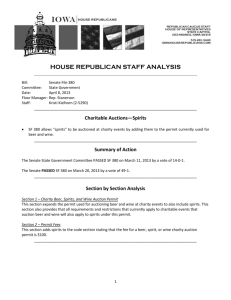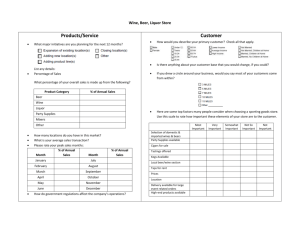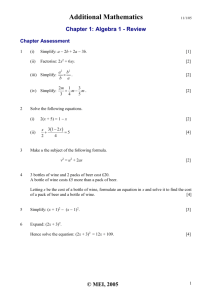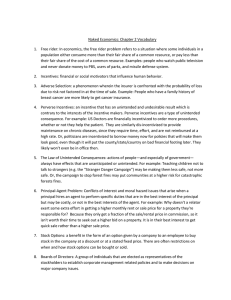T R E C
advertisement
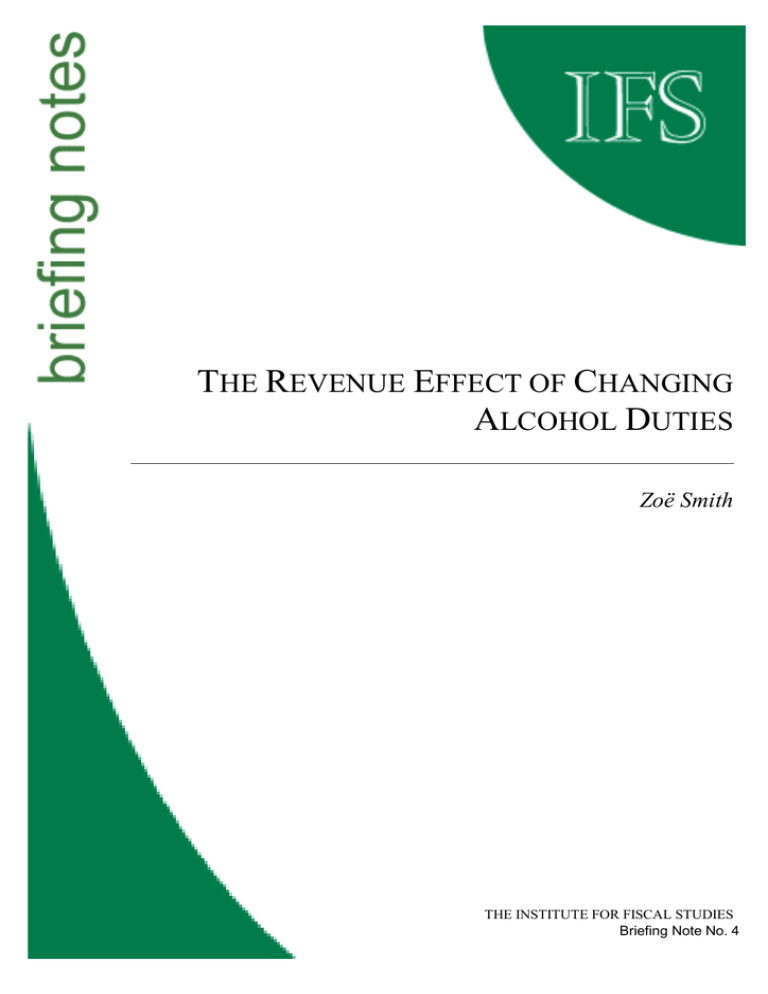
THE REVENUE EFFECT OF CHANGING ALCOHOL DUTIES Zoë Smith THE INSTITUTE FOR FISCAL STUDIES Briefing Note No. 4 Published by The Institute for Fiscal Studies 7 Ridgmount Street London WC1E 7AE Tel 020 7291 4800 Fax 020 7323 4780 mailbox@ifs.org.uk www.ifs.org.uk © Institute for Fiscal Studies, November 1999 ISBN 1-903274-05-2 Published online at http://www.ifs.org.uk The revenue effect of changing alcohol duties1 Zoë Smith Introduction Since the completion of the Single European Market in 1992, it has become easier for people in the UK to take advantage of lower-priced goods across the border. Alcohol is one good where there has been particular concern about the level of cross-border shopping because of differences in tax rates between the UK and France. HM Customs and Excise estimated that in 1998, £290 million of revenue from beer, wine and spirits was lost through cross-border shopping.2 This contrasts with £10.86 billion of total duty and VAT receipts3 collected on alcohol. If the Chancellor cut duty, the volume of cross-border shopping could be reduced and more revenue would be collected from any increase in domestic sales, but less revenue would be collected from each unit that is currently sold. If the Chancellor wants to reduce the amount of cross-border shopping by cutting duty, the important policy question is whether, overall, these two effects on revenue would be positive or negative. Alcohol tax rates and revenues Two indirect taxes are charged on alcohol in the UK. All alcohol is subject to the standard rate of value added tax (17.5 per cent). In addition, excise duties are levied at different rates according to the type of alcohol. Duty on beer and spirits is charged – at different rates – according to alcoholic content. The rate of duty on wine is applied to the volume of wine and the same duty rate is applied to wine within a range of strengths. Table 1. Alcohol taxes, January 1999 Duty on typical unit Implied duty Duty + VAT per litre of pure alcohol as % of final price Beer 25p per pint £11.50 30% Wine £1.12 per 75cl bottle £14.56 51% Spirits £5.48 per 70cl bottle £19.56 62% Note: Typical units are defined as follows: for beer it is a pint of bitter at 3.9% abv, bought on licensed premises; for wine it is a 75cl bottle of table wine at 10.25% abv; and for spirits it is a 70cl bottle of whisky at 40% abv. Note that for beer and wine, the implied duty per litre of pure alcohol does not depend on the strength used to calculate duty on a typical unit. Source: HM Customs and Excise, Annual Report 1998–1999, The Stationery Office, London, November 1999. Table 1 shows the duty on a typical unit of beer, wine and spirits. Since duty is imposed on different drinks in different ways, it not immediately clear how the rates on different drinks compare. The last two columns in the table show two alternative ways of comparing duty across different drinks in a meaningful way. Whether we compare duty per litre of pure alcohol or duty plus VAT as a percentage of final price, spirits are taxed much more heavily than beer or wine. In terms of duty per litre of pure alcohol, spirits are taxed more than 70 per cent more heavily than beer and nearly 35 per cent more heavily than wine. 1 This is a shorter version of I. Crawford, Z. Smith and S. Tanner, ‘Alcohol taxes, tax revenues and the Single European Market’, Fiscal Studies, vol. 20, no. 3, pp. 287–304, 1999. 2 Pre-Budget Report, November 1999. Note that in our analysis we do not need to measure the level of crossborder shopping directly to estimate the effect on tax revenues of excise duty changes. 3 Total receipts are calculated from figures on duty receipts taken from HM Customs and Excise, Annual Report 1998–1999, The Stationery Office, London, November 1999, plus an amount for VAT based on consumer expenditure on alcohol taken from Office for National Statistics, Consumer Trends, 1999. Table 2. EU duty rates on alcohol as at 1 September 1999 Beer/pint @5% abv (pence) Austria 7 Belgium 8 Denmark 18 Finland 56 France 5 Germany 4 Greece 6 Ireland 39 Italy 7 Luxemburg 4 Netherlands 8 Portugal 6 Spain 3 Sweden 31 UK 33 Source: Wine and Spirits Association. Country Wine/75cl @11% abv (£) nil 0.25 0.49 1.23 0.02 nil nil 1.43 nil nil 0.25 nil nil 1.53 1.12 Spirits/70cl @40% abv (£) 1.41 3.23 7.20 9.81 2.82 2.54 1.79 5.41 1.26 2.03 2.93 1.58 1.34 10.53 5.48 These rates of duty are among the highest in the European Union. Table 2 compares the duty rates in different EU countries for beer, wine and spirits and shows, for example, that the duty on beer is more than six times higher in the UK than in France. (Note that this is for beer at 5 per cent abv, not 3.9 per cent abv which is the strength used in Table 1.) VAT is also levied on alcohol but this is not reflected in the table. The VAT rate in France, for example, is 20.6 per cent compared with 17.5 per cent in the UK, so this would narrow the gap between total tax rates to some extent. The large differences in duty provide a financial incentive for UK consumers to shop across the border. One way to reduce this incentive would be to cut duty in the UK. But would this enable the Chancellor to recoup some of the revenue that he is losing to cross-border shopping or would it result in further revenue losses? Decreasing the tax rate would increase domestic sales but less revenue would be collected on each unit sold. Whether the overall result would be an increase or decrease in revenue depends on the balance between these two effects. Figure 1. Revenue maximisation Tax revenue, R R* τ* Tax rate, t Figure 1 represents the idea that there is a non-linear relationship between the tax rate and tax revenue. If the tax rate is zero, then revenue is also zero. There will also be a tax rate that is so high that no one would buy the good so no revenue would be collected. Somewhere in between these two extremes there will be a rate that maximises revenue. Increasing the tax rate from zero will lead to increases in revenue, but only up to a tax rate of τ*. If the tax rate is less than τ*, then cutting duty will lead to a fall in total revenue because the revenue loss on each unit sold outweighs the gain from increased sales. At a tax rate of τ*, tax revenue is at a maximum. It is only if the tax rate is greater than τ* that cutting duty will lead to an increase in revenue. At tax rates above τ*, the loss per unit sold from a reduction in the rate is outweighed by the gain from increased sales. For any particular good, the relationship between the tax rate and tax revenue depends on total expenditure on the good, the current tax rates and how responsive consumers are to a change in the price of the good (the price elasticity of demand). Other things being equal, the more responsive people are to a change in the price of a good, the more likely it is that a cut in duty will lead to an increase in revenue. This is because, for a given fall in price after a tax cut, the more responsive people are, the larger the increase in sales, so the more likely it is that the extra revenue from the increase in sales will outweigh the loss per unit sold. It is also important to consider the effect that cutting duty on one type of alcohol would have on the demand for, and therefore the revenue from, other types of alcohol and all other goods. A change in the price of, say, beer will lead to a reallocation of spending between beer and all other goods. The effect is likely to be greatest on the demand for other types of alcohol because of the similarity between different types of alcohol. If beer and wine are complements to each other, then when the price of beer falls (following a tax cut) people buy more beer and also more wine. This means there will be an increase in revenue from wine, so we are more likely to see an increase in total tax revenue following a tax cut on beer. If beer and wine are substitutes for each other, a fall in the price of beer will lead to an increase in sales of beer but a fall in sales of wine. The result would be a fall in revenue from wine, so we are less likely to see an increase in total revenue following a tax cut on beer. The responsiveness of demand for one good with respect to a change in the price of another good is called the cross-price elasticity of demand. Also important for the total revenue effect is the rate at which the complement or substitute is taxed. The more heavily the complement or substitute is taxed relative to the good itself, the more likely the change in revenue from the complement or substitute will outweigh any opposite effect on revenue from the good itself. This is because, for a given change in demand, the higher the tax rate, the greater the change in revenue. Results In order to determine whether cutting duty would lead to an increase or a decrease in revenue, we need to know expenditure, current tax rates and own- and cross-price elasticities. We know current tax rates and expenditure and we use data from the Family Expenditure Survey from 1979–96 (about 120,000 households) to estimate elasticities. We evaluate the elasticities for the period after the completion of the Single European Market. We might expect the elasticity in the south-east to be different from that for the UK as a whole since the fixed cost of crossing the border is lower, so we compare elasticities for the UK with those for the south-east. However, we find no significant difference between the two. We also might expect the elasticities for the period after the completion of the Single Market to differ from those before, since consumers now have an additional way in which to respond to an increase in price. We test whether the elasticities for the two periods are different, but again we find no significant difference. Table 3. Estimated elasticities for the UK, 1993–96, εˆ sm ji j= Beer Beer –0.76 (0.094) i= Wine –0.17 (0.087) Spirits –0.20 (0.120) Note: Figures in parentheses are standard errors. Wine –0.60 –1.69 0.77 Spirits –0.59 0.66 –0.86 (0.282) (0.464) (0.525) (0.329) (0.449) (0.763) Since the elasticities are not significantly different in the south-east or in the different time periods, the elasticities that we use to determine the revenue effect of cutting duty are those for the whole of the UK after the completion of the Single Market. The elasticities are reported in Table 3, with standard errors in parentheses. The numbers in the table show the change in the quantity demanded of the drinks in each column with respect to changes in the price of the drinks in each row. The diagonal elements are the own-price elasticities. For example, the own-price elasticity of beer is –0.76. This means that if the price of beer falls by 1 per cent, there will be a 0.76 per cent rise in the quantity of beer demanded. Of these three types of alcohol, beer is the least price-responsive and wine is the most, although the results are not significantly different from each other. Equally important are the cross-price elasticities. For example, the number in the first row of the wine column shows the change in the quantity of wine demanded with respect to a change in the price of beer. Since this number is negative, it tells us that an increase in the price of beer would lead to a fall in the demand for wine, so beer and wine are complements. The amount by which demand for wine would fall for a 1 per cent increase in the price of beer is 0.6 per cent. The fact that beer and wine are complements means that, if duty on beer were cut, demand for wine would rise, so there would be an increase in revenue from wine. Since the cross-price elasticity of spirits and beer is negative, these drinks are also complements, whereas the cross-price elasticity of spirits and wine is positive, which means they are substitutes. Table 4. The effect of cutting duty on alcohol Beer Wine Spirits Overall Cut in beer duty Sales Increase Increase Increase Revenue Decrease Increase Increase Decrease Cut in wine duty Sales Increase Increase Decrease Revenue Increase Increase Decrease Decrease Cut in spirits duty Sales Revenue Increase Increase Decrease Decrease Increase Increase At maximum Table 4 summarises the effect that cutting duty on one type of alcohol would have on its own sales and revenue and on the sales and revenue of the other types of alcohol. A cut in beer duty will lead to an increase in sales of beer, but beer is not very priceresponsive and so the increase in sales is not enough to outweigh the fall in duty on each unit sold. Thus a cut in beer duty would lead to a fall in revenue from beer. But we also have to take into account the effect that a cut in beer duty would have on wine and spirits revenue. Beer is a complement to wine, so a cut in beer duty would lead to an increase in sales of wine and so an increase in revenue from wine. Beer is also a complement to spirits, so again a cut in beer duty will lead to an increase in sales of spirits and this means an increase in revenue from spirits. The increase in revenue from wine and spirits would offset the loss of beer revenue, but not completely. Overall, we find that a cut in beer duty would lead to a fall in indirect tax revenue. A cut in wine duty will lead to an increase in sales of wine. Wine is the most price-responsive of the three types of alcohol and, unlike beer, we find that the increase in sales following a tax cut is sufficient to outweigh the loss of revenue per unit sold, meaning that a cut in wine duty would lead to an increase in revenue from wine. Beer and wine are complements, so there would also be an increase in sales of beer and an increase in revenue from beer. However, the effect on spirits works in the other direction. A cut in wine duty would decrease sales of spirits (since wine and spirits are substitutes) and so reduce revenue from spirits. Since spirits are taxed the most heavily, this effect is relatively large and it offsets the increase in revenue from wine and beer. Overall, we find that, as for beer, a cut in wine duty would lead to a fall in indirect tax revenue. This shows the importance of taking the cross-price effects into account. A cut in duty on spirits would lead to an increase in revenue from spirits. Beer is a complement to spirits, so a cut in spirits duty would lead to an increase in beer sales and an increase in beer revenue. But, since wine is a substitute for spirits, a cut in spirits duty would lead to a fall in sales of wine and this means a fall in revenue from wine. Overall, we find that we cannot reject that the duty rate on spirits is at the revenue-maximising rate. This means that there is little scope for the Chancellor to increase indirect tax revenue by raising or cutting duty on spirits, since at the current tax rate he is already getting the maximum amount of revenue. Conclusion The Chancellor faces a dilemma. If he cuts duty on beer, wine or spirits, he would probably reduce the amount of cross-border shopping but the result would be further revenue losses. Our results suggest, in fact, that the Chancellor could get more revenue by increasing the tax rates on beer and wine. Spirits are different, however, because there is little scope to increase indirect tax revenue by increasing the tax rate. Our research addressed the very specific issue of whether the Chancellor would lose or gain revenue by cutting duty on alcohol. The results do not mean that there are no reasons for cutting duties to reduce the volume of cross-border shopping, but they do mean that such cuts are likely to cost the Chancellor revenue.
